The AMD 3rd Gen Ryzen Deep Dive Review: 3700X and 3900X Raising The Bar
by Andrei Frumusanu & Gavin Bonshor on July 7, 2019 9:00 AM EST** = Old results marked were performed with the original BIOS & boost behaviour as published on 7/7.
Gaming: Ashes Classic (DX12)
Seen as the holy child of DirectX12, Ashes of the Singularity (AoTS, or just Ashes) has been the first title to actively go explore as many of the DirectX12 features as it possibly can. Stardock, the developer behind the Nitrous engine which powers the game, has ensured that the real-time strategy title takes advantage of multiple cores and multiple graphics cards, in as many configurations as possible.
As a real-time strategy title, Ashes is all about responsiveness during both wide open shots but also concentrated battles. With DirectX12 at the helm, the ability to implement more draw calls per second allows the engine to work with substantial unit depth and effects that other RTS titles had to rely on combined draw calls to achieve, making some combined unit structures ultimately very rigid.
Stardock clearly understand the importance of an in-game benchmark, ensuring that such a tool was available and capable from day one, especially with all the additional DX12 features used and being able to characterize how they affected the title for the developer was important. The in-game benchmark performs a four minute fixed seed battle environment with a variety of shots, and outputs a vast amount of data to analyze.
For our benchmark, we run Ashes Classic: an older version of the game before the Escalation update. The reason for this is that this is easier to automate, without a splash screen, but still has a strong visual fidelity to test.
| AnandTech CPU Gaming 2019 Game List | ||||||||
| Game | Genre | Release Date | API | IGP | Low | Med | High | |
| Ashes: Classic | RTS | Mar 2016 |
DX12 | 720p Standard |
1080p Standard |
1440p Standard |
4K Standard |
|
Ashes has dropdown options for MSAA, Light Quality, Object Quality, Shading Samples, Shadow Quality, Textures, and separate options for the terrain. There are several presents, from Very Low to Extreme: we run our benchmarks at the above settings, and take the frame-time output for our average and percentile numbers.
All of our benchmark results can also be found in our benchmark engine, Bench.
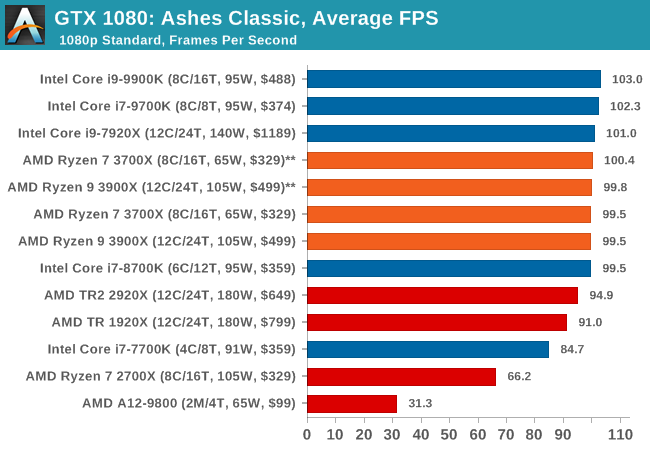
| Ashes Classic | IGP | Low | Medium | High |
| Average FPS | 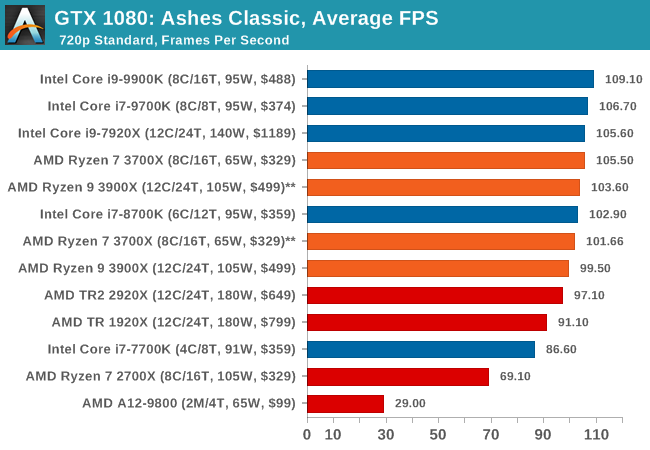 |
 |
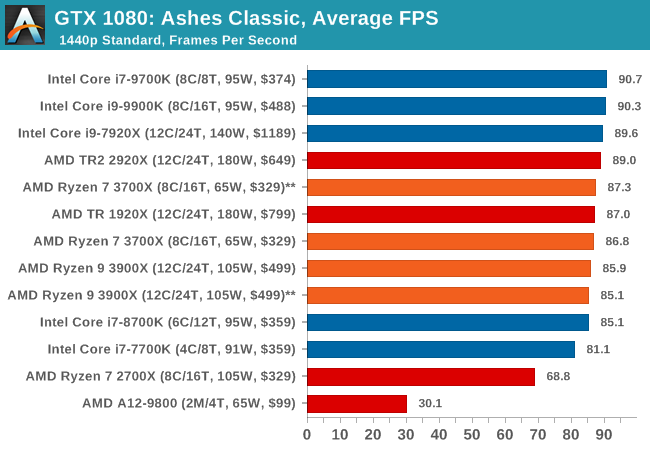 |
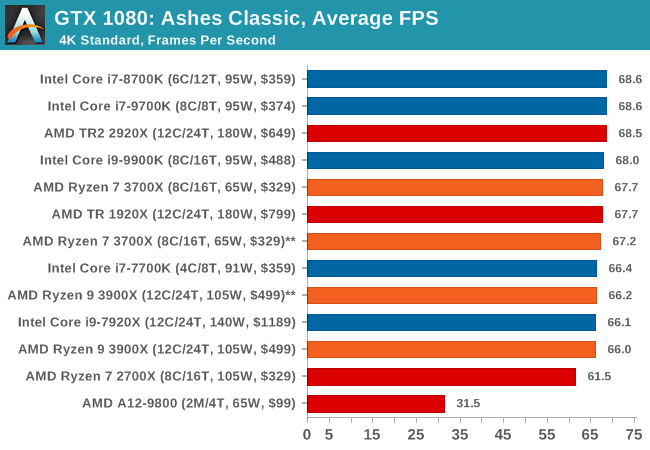 |
| 95th Percentile | 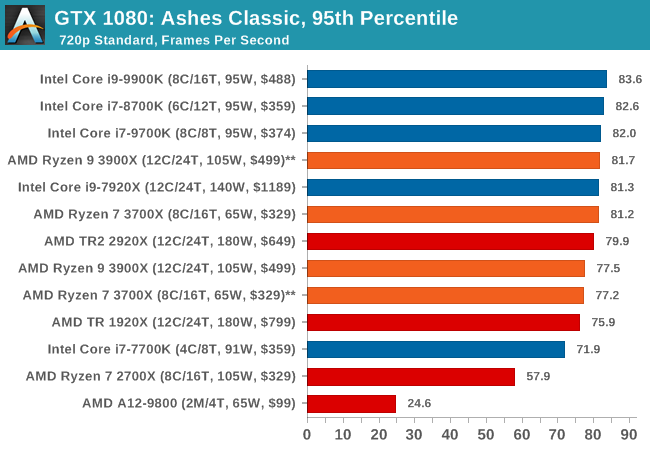 |
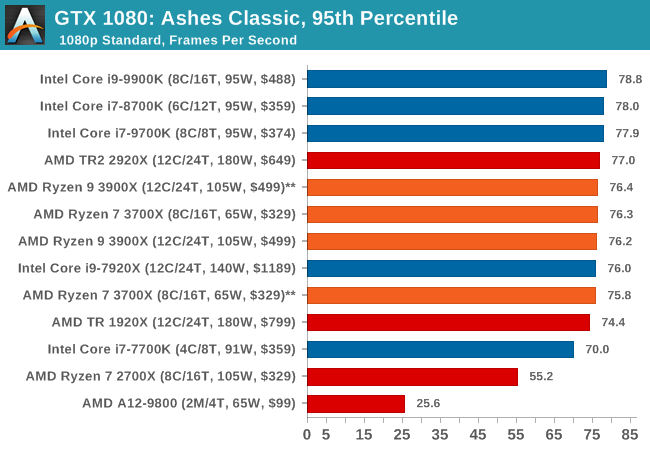 |
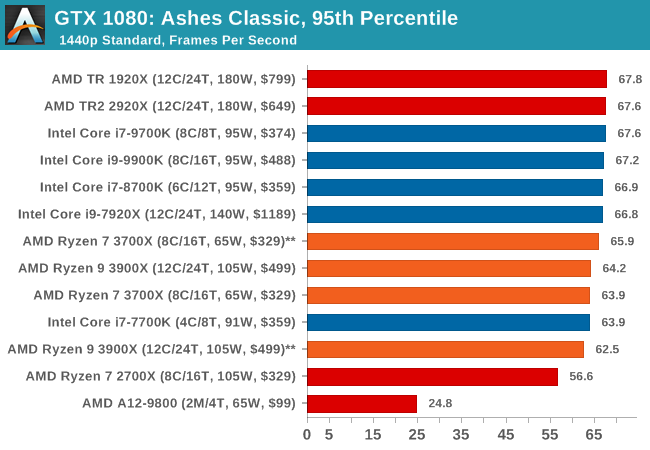 |
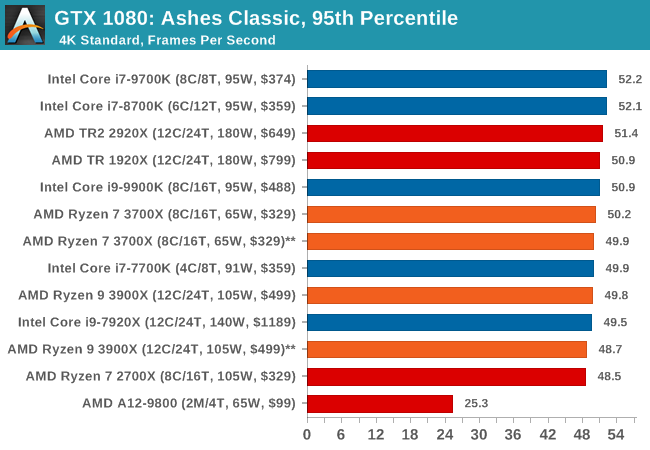 |


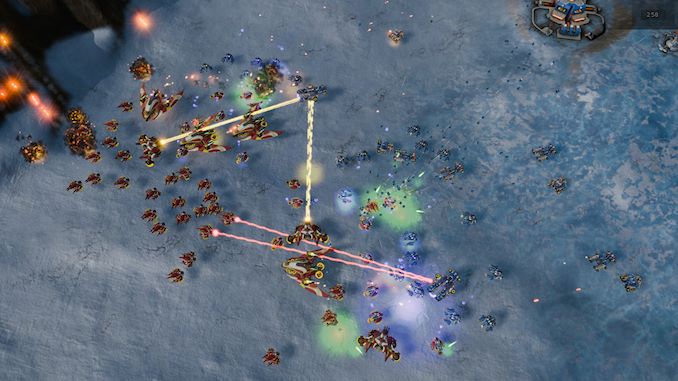








447 Comments
View All Comments
Tkan215 - Monday, July 8, 2019 - link
I dont think so its not easy to refine 10nm like you think how many year it take Intel to refine 10nm it has been already 4 to 5 years dont get your hope up. If volume aint there there is no chance. AMD surelly moving to 7nm euv quicker then 5nmTkan215 - Monday, July 8, 2019 - link
I havent seen them drop any price i9900k went back up at amazon.com. Intel continue to ignore, non response and not caring for their competition. they want their margin this is all this company care about not your feeling or desireTEAMSWITCHER - Sunday, July 7, 2019 - link
It's summer time in Michigan and I have no desire to upgrade right now... I can wait for the flagship 3950X in September.Maxiking - Sunday, July 7, 2019 - link
Local anandtech yield and node experts got hit again. I wonder how many hits you can take before you shut up.As predicted, Intel still faster in games and AMD OC ability more or less unchanged, slighty worse. It is a new node after all buy yeah, you know better, so keep dreaming about those 5ghz on the majority of chips.
Teckk - Sunday, July 7, 2019 - link
So more cores at the same TDP as 2000 series Ryzen is nothing? Ok.Maxiking - Sunday, July 7, 2019 - link
That isn't the thing I was talking about. My point was that local experts, I mean, trolls, know nothing about the manufacturing cost, yields, about the node in general. As it has been showed recently in the reviews, OC ability of the chips is terrible and lower core count parts tend to perform worse, reaching only 4.1 - 4.2 ghz.Teckk - Sunday, July 7, 2019 - link
Ah, got it. It is an improvement, but not good enough.Maxiking - Sunday, July 7, 2019 - link
It is good enough in terms of competition and that we can get things cheaper.But not when the raw performance is tconsidered. It is a hypothetical scenario, but had there been no 10 nm problems for Intel, AMD would have been in the bulldozer position again.
catavalon21 - Sunday, July 7, 2019 - link
I haven't owned an AMD CPU since my K500 a very long time ago, but let's call it what it is - AMD has a CPU at the $500 price point that Intel is charging $1200 presently to compete with, and Intel's solution uses far more power. That's a win for AMD in any domain.imaheadcase - Sunday, July 7, 2019 - link
The problem is that the PC market is stagnant atm, if you are already a intel owner, absolutely no reason to upgrade to amd CPU. Most people who have systems now don't really have any need to upgrade like it used to be.He stated in article it took amd 15 YEARS to get this good CPU finally out and sounded like he was impressed by that?
Its a impressive CPU, but lets be real here, Intel has dominated the market already for years because it has better marketing, better suppliers.
Based on previous article comments, most people are still rocking 2600K CPU..FROM 2011! They still are very good CPU.
Thats not counting the price difference, while yes the one intel cpu is crazy expensive, its not a normal CPU most people have to go by, if you a regular user with the previous mentioned 2600K CPU..that requires a total system overhaul if you wanted to go AMD route...which to be honest is a risk on betting that a new amd system is not going to last as long as a 2600K did for you.